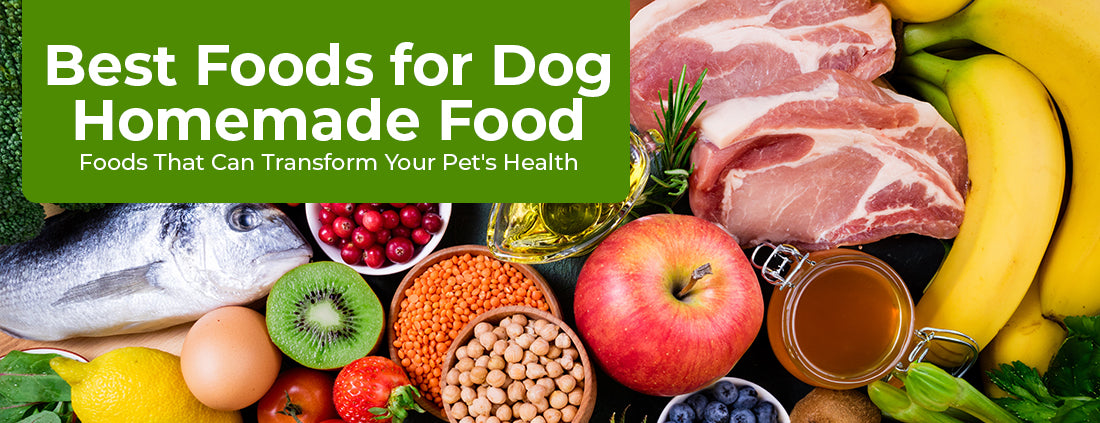If you’re looking to create dog food for your best furbuddy, congratulations! You’ve just embarked — pun intended — on an exciting journey that can reward your pup with a healthier and longer life. By crafting homemade meals, not only are you providing higher-quality nutrition at a lower cost, but you're also investing in preventive health measures that can minimize vet and grooming expenses. This is why creating our dogs’ food at home is viewed by many as one of the best things we can do for our best friends.
With that said, what are the best foods to put in homemade dog food? Today, we’re here to show you the best of the best and how ChefPaw, the dog food maker, can make the entire process even easier!
4 Pro Tips For Selecting The Best Foods
Before we break down the best foods for creating dog food at home, let’s look at 4 helpful tips so you can get started right away.
1. Starting With A Good Recipe
When The University of California, Davis, School of Veterinary Medicine tested 200 recipes for home-prepared dog foods, 95% did not meet National Research Council or Association of American Feed Control Officials (AAFCO) guidelines for at least one essential nutrient. 83.5% of those tested recipes featured multiple deficiencies.
To add further insult to injury, despite good intentions, pet parents were often seen improperly swapping one ingredient for another. For example, despite having the same calories and both being oils, coconut oil lacks linoleic acid and can not replace corn oil. Unlike brown rice, quinoa is a more complete protein source and contains more fiber and micronutrients like iron and magnesium compared to brown rice.
Thanks to ChefPaw's large library of recipes that all meet AAFCO guidelines and its’ nutrient analyzer that reanalyzes recipes when customized, pet parents can rest assured their meals are formulated for their dog’s needs. Additionally, ChefPaw can connect you to a nutritionist who can create customized recipes for your dog or ensure the ones you’re giving them are complete and balanced based on their needs.
2. Preparing The Recipe
Never swap ingredients in a recipe without consulting ChefPaw’s nutrient analyzer first, which formulates the preprogrammed recipes to your dog’s weight, age, etc. We also recommend using ChefPaw’s built-in food scale when weighing out ingredients. Last, make sure you are following recipes down to the letter while letting ChefPaw complete the required cooking times.
3. Adding Supplements
Whether created at home or in a commercial setting, the best dog foods are fortified with a large number of vitamins to ensure they are delivering everything your dog needs. Even when meals are put together correctly, and feature a large range of ingredients, it's very common for these meals to be deficient in minerals like calcium. As such, if you are uncomfortable supplementing in a few select supplements, we recommend sticking to commercial foods. But again, these commercial foods are likely fortified as well.
4. Monitoring Your Dog
You will want to monitor your dog closely for about a month when transitioning to a homemade diet. In particular, you want to look for undesired changes in their weight, stool, and energy levels. Slowly transition to homemade meals over 1-2 weeks as an immediate transition can upset digestion.
Protein
It can be a bit tricky when advising the importance of protein when creating your own dog food. While it’s true that sources of protein should be the first place you look, especially due to allergy concerns, protein shouldn’t make up as much of the modern dog’s diet vs. their ancestors.
When allowed to self-select their food, the average dog only chose to get 30% of their daily energy needs from protein (Hewson-Hughes et al., 2012). Now, 63% of the energy they choose came from fat, which is intricately tied with animal-based proteins.
Animal-Based Proteins
As a general rule of thumb, meat and other animal-based foods like eggs, organs, etc., are going to make up the majority of a dog’s diet. This is because meat supplies both protein and fat, which is 2 of the 3 macronutrients.
Another reason animal meat will make up a good part of your dog’s diet is that high-quality sources can easily provide all 10 essential amino acids in abundance. Incomplete sources can be used, as we are about to see, but will need to be carefully combined with other incomplete sources to ensure they cover what the others are missing.
Meat - Chicken, beef, lamb, and fish are excellent sources of protein and each alone can provide the 10 essential amino acids. These protein sources are all very popular choices and easy to find, however, these meats, especially chicken and beef, are the most common food allergens due to overexposure. Novel proteins, such as bison, turkey, and pork are excellent alternatives.
By-Products - Organ meat like liver and kidneys can be an affordable way to give our dogs nutrient-dense foods. They must be limited due to their incredible nutrient density, which can lead to toxicities.
Eggs and Dairy - While eggs have a good bit of fat, they are considered a high source of protein and have incredible bioavailability when cooked. While milk doesn’t need to be a part of your dog’s diet, cottage cheese and yogurt provide a lot of high-quality protein and probiotic support.
Plant-Based Proteins
There is little reason to shy away from plant-based proteins as they can offer all the essential amino acids a dog needs when properly combined. Then they can offer some additional fiber support that animal-based proteins lack. Great sources of plant-based proteins include oats, peas, beans, and soy.
Now, there are a few ‘complete’ or ‘nearly complete’ plant-based proteins such as hempseeds, buckwheat, and quinoa. However, when compared to animal-based proteins, while they may have all 10 amino acids, some are in very low amounts.
Carbohydrates And Fiber
While some carbohydrates should be left off the table, carbohydrates are essential to your dog’s diet thanks to their bountiful amounts of fiber that support digestive health. Active dogs, in particular, will do well when they see carbohydrates in their diet, as carbs provide a great source of on-demand energy.
Grains
When it comes to grains, you’ll want to focus on the two main types: whole grains and refined grains. Both types are safe for dogs, but placing a greater focus on serving whole grains should be your goal.
Whole grains like brown rice, oatmeal, quinoa, and barley are better sources of fiber, vitamins, minerals, and antioxidants compared to refined grains. One place where refined grains can come in handy occurs when your dog needs a fast and easier-to-digest source of carbs. For example, white rice is easier to digest on an upset stomach and serves as a faster source of energy when compared to brown rice.
Vegetables
When shopping for commercial dog foods, you’ll commonly see peas, sweet potatoes, and carrots as some of the main ingredients. These vegetables can all have a place in the homemade meals too. By including leafy greens high in fiber and antioxidants and bell peppers rich in vitamins like vitamin C, along with various carotenoids, we can elevate homemade meals even further.
Fruits
Rich in incredible ranges of vitamins and minerals, along with delivering healthy doses of fiber, fruits can be a main staple in your dog’s meals. Now, due to their higher sugar and lower fiber content, fruits shouldn’t be anywhere as abundant in your dog’s diet as vegetables. However, there are areas where they work better, e.g., fruits often contain higher levels of specific nutrients such as vitamin C and certain antioxidants while additionally having higher water content on average.
Fat And Oils
Fats are an essential part of a dog’s diet, though we do need to keep track of how much we give them. This is because a gram of fat has three times the amount of calories (energy) vs. protein and carbohydrates. Fats are essential to hormone production and play a significant influence on skin and coat health. Healthy fats can come from a range of sources, including fish, vegetable oils, and legumes like peanuts.
Supplementing Vitamins And Minerals
There are a lot of supplements out there for our dogs to take, and while a few are essential, there is little reason to overload yourself with all of them. So let’s start with the one supplement that is essential for pretty much all homemade diets.
Complete Calcium & Multivitamin Dog Supplement
Even when using ingredients high in calcium, such as eggshells, a supplement containing calcium is essential in nearly every case. Because calcium isn’t the only vitamin and mineral deficiency seen in homemade diets, ChefPaw Nutrition Booster will work best in the majority of cases.
Fish Oil
If your dog’s main source of protein isn’t coming from fish, a fish oil supplement rich in DHA and EPA is a great idea for nabbing those essential omega-3 fatty acids. Not only do omega-3s help lower inflammation by counteracting omega-6s, but they are also important for supporting cardiovascular and cognitive health.
Probiotic
Foods like sweet potatoes and yogurt can go a long way to satisfy your dog’s probiotic needs. But if you still see them struggling with digestive issues or they have an allergy to these foods, consider a probiotic supplement.
CBD Oil
CBD for pets is all the rage lately! Research and pet parents are finding it can help our dogs with a multitude of health issues: anxiety, poor digestion, inflammation, and pain, to name a few.
Including CBD in your dog’s food couldn’t be easier thanks to its oil base. As well, ChefPaw's gentle cooking process will protect the cannabinoids and terpenes in the CBD oil from excessive heat that’s seen with other cooking methods.
CBD pairs perfectly with multiple daily feedings. In the morning, CBD can help calm their anxiety as you leave for work. Then at night, it can help reduce aches and pains that keep them up at night. This is why CBD is one of our favorite supplements we include when we’re making our dogs’ food for them at home.


